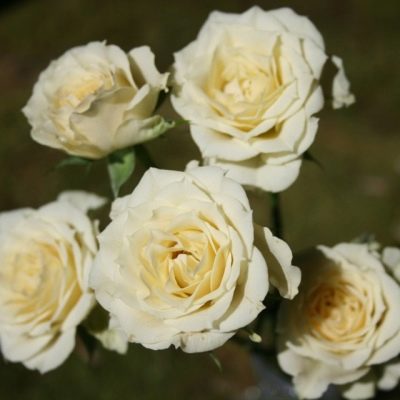
- Authors: W. Kordes & Sons
- Name synonyms: Vanilla
- Breeding year: 1994
- Group: climbing, floribunda
- The main color of the flower: white
- Flower shape: classic high center
- Flower size: medium
- Diameter, cm: 4-6
- Flower type by number of petals: medium terry
- Scent: pleasant, fruity
Vanilla belongs to the category of hybrid tea roses, which are especially popular with flower growers and landscape designers. There are several reasons for this. The variety has a pleasant aroma, high decorative effect, is resistant to cold weather, as well as to diseases and pest attacks. In order for a shrub to look really attractive, it is necessary to comply with the conditions for its cultivation.
Description of the variety
The variety was developed by German breeders W. Kordes & Sons in 1994. Vanilla belongs to the group of climbing roses intended for cutting.
The bush is low with spreading shoots, reaches a height of 70-80 cm, the width varies from 80 to 140 cm, depending on the conditions of detention, as well as age. The leaves are quite dense, deep green in color.
The variety differs in that it is sufficiently resistant to cold weather, therefore, it is suitable for growing in central Russia, as well as in the territory of the northern regions, if the conditions of agricultural technology are strictly observed.
Advantages and disadvantages
The variety has certain advantages and disadvantages. There are more positive points, they are as follows:
- frost resistance;
- pleasant aroma;
- relative unpretentiousness in care;
- a large number of buds on each bush.
In addition, there are practically no thorns on the bushes of the Vanilla variety, which makes the plant and bouquets safer.
Despite the large number of advantages, disadvantages are also present. The most noticeable of them is that the shrub does not tolerate the rainy season and gets sick even with a slight violation of the irrigation regime.
Flowering features
Flowers can be either single or in inflorescences. On one stem, there are from 5 to 10 pieces. The buds are pointed, and the flowers are classic. The color of the petals is white with a center of yellow-cream shade.
The flowers are medium-double, rather large, since the specimens reach 4-6 cm in diameter. They have a pleasant fruity aroma, which evaporates quickly enough. The flowering period begins in July and ends only in September.
Landing
Planting roses of this variety is possible both in spring and autumn. For this purpose, it is necessary to choose a sufficiently illuminated area with loose and fertile soil.
To do this, dig holes, moisten the soil, place a seedling there, sprinkle it with earth and water it again. For planting, you should choose a day with warm and dry weather.
Growing and care
Once the seedlings have been moved outdoors, they require particularly careful maintenance and supervision. At first, experienced gardeners recommend equipping a mini-greenhouse to protect the plant from the negative influence of the external environment.
Watering should be done as the soil dries up. In no case should it be excessively moisturized. This will negatively affect the condition of the bushes. The fact is that roses of this variety do not tolerate moisture in large quantities. Because of this, some flowers are damaged. If the amount of moisture does not decrease, then they remain at the bud stage, gradually falling off.
If roses are grown in the middle lane, as well as in the northern regions, for the winter they should be insulated with a covering material. Otherwise, freezing is not excluded.
Diseases and pests
The most common diseases that affect this variety are powdery mildew and black spot. They appear due to weakened immunity, as well as due to non-compliance with the conditions of agricultural technology.
In order to get rid of diseases, it is necessary to spray with chemicals. So, for getting rid of powdery mildew, fungicides "Fundazol" and "Topaz" are ideal. Can be treated with Fitosporin-M.
With black spot, dark gray or black spots appear on the leaves. For treatment, fungicides are suitable, which contain zinc. For prophylaxis in the fall, it is necessary to dig up the soil, as well as remove and burn fallen leaves.
The most common rose pests are:
- aphid;
- leaf beetles;
- spider mite.
All of them feed on the sap and pulp of plants, causing significant harm to the latter. To get rid of it, it is recommended to treat the bushes with a solution of colloidal sulfur, as well as the preparations "Intavir" or "Aktara".
If you follow all the growing conditions, as well as timely protect the plant from pests and diseases, then it will bloom profusely for almost 2.5 months. Roses can be left directly on the bushes or cut for the purpose of further creating bouquets.































































